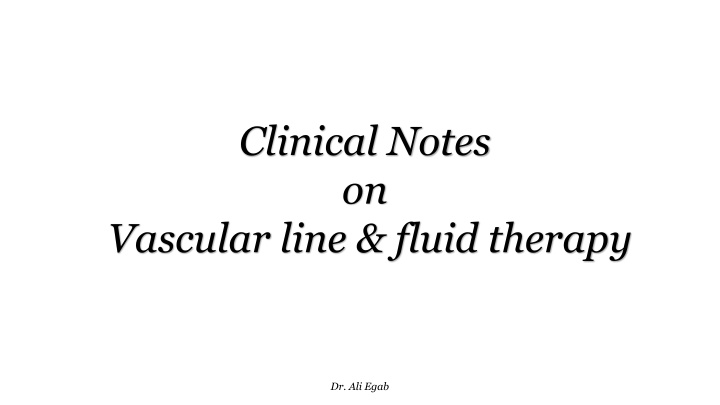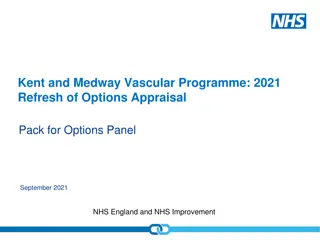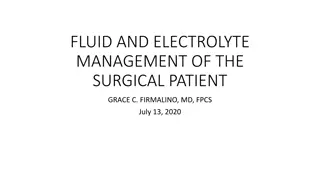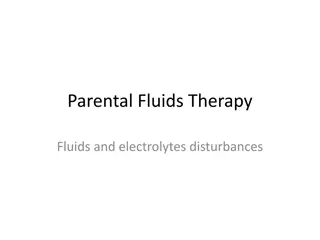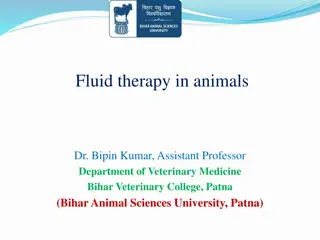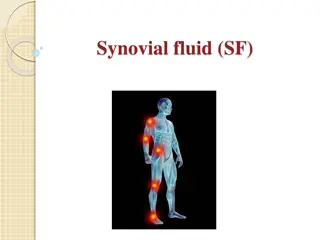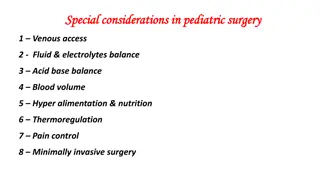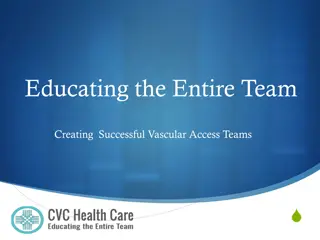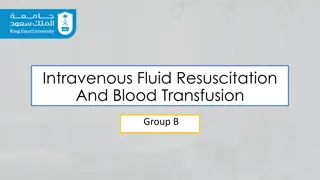Clinical Notes on Vascular Line & Fluid Therapy by Dr. Ali Egab
This collection of clinical notes by Dr. Ali Egab covers various aspects of vascular access, types of veins used for IV therapy, considerations in vein selection, equipment for IV therapy, cannula gauge, rate of infusion, and local complications of vascular lines. The notes provide valuable insights into selecting appropriate veins for venipuncture, equipment used in IV therapy, and managing local complications such as thrombosis and infection. By outlining different types of vascular access and important considerations, these notes serve as a comprehensive guide for healthcare professionals involved in fluid therapy.
Download Presentation

Please find below an Image/Link to download the presentation.
The content on the website is provided AS IS for your information and personal use only. It may not be sold, licensed, or shared on other websites without obtaining consent from the author.If you encounter any issues during the download, it is possible that the publisher has removed the file from their server.
You are allowed to download the files provided on this website for personal or commercial use, subject to the condition that they are used lawfully. All files are the property of their respective owners.
The content on the website is provided AS IS for your information and personal use only. It may not be sold, licensed, or shared on other websites without obtaining consent from the author.
E N D
Presentation Transcript
Clinical Notes on Vascular line & fluid therapy Dr. Ali Egab
Types of vascular Access 1- umbilical V or A catherisation (in neonate) 2- peripheral venous cannulation (most common) 3- peripherally introduced central venous catheter 4- central venous line (in ICU). 5- totally implanted central venous catheter 6- intra-osseous access (in infants and children). 7- peripheral venous cutdwon 8- arterial catheter. 9- AV fistula for hemodialysis catheter Dr. Ali Egab
Veins used for IV therapy There are four basic things to consider when selecting a vein for venipuncture: Location condition of the vein Catheter or Cannula Size purpose of the infusion duration of the IV therapy. Vein of upper extremity better than lower extremities. veins of the lower extremity have more risk of stagnant blood flow, risk for thrombus, and infection. And tends to be more difficult in cannulation due to the condition of the veins. Dr. Ali Egab
Considerations in the Selection of a Suitable Vein Patient's Current Health Problem and Disease History. Like diabetes or chronic obstructive pulmonary disease. Age of Patient. Condition of Skin. Limb Mobility. Fluid Volume Status. Cognitive Level and Psychological Status. Patient Activity and Personal Preference. Other Patient Specific Conditions. o Placement of an intravenous line on the same extremity as any of the following conditions is contraindicated: o Mastectomy o arteriovenous shunt or fistula o hemodialysis shunt o Graft o serious burns or grafts o paralysis Dr. Ali Egab
Equipment of IV therapy 1- Containers: glass or plastic 2- Tubing and Administration Sets 3- Venous Access Devices: cannula, catheter 4- Dressings: gauze and tape or transparent, semi-permeable dressing 5- Gravity 6- Controllers / electronic infusion pump Pumps Dr. Ali Egab
Cannula gauge & rate of infusion Dr. Ali Egab
Local complication of vascular line echymosis or Hematoma Infiltration Extravasation Thrombosis Thrombophlebitis: Symptoms sluggish IV flow rate, swollen extremity, warm venipuncture site, tender vein cordlike and redness along the course of the vein. Local Infection Dr. Ali Egab
Intravenous fluid therapy General Indications of Intravenous Therapy O Fluid, electrolyte and blood or blood product administration. O Medication administration. O Parenteral nutrition. O Diagnostics and hemodynamic monitoring. O Precautionary IV access. Dr. Ali Egab
Advantages of IV therapy Direct access to the circulatory system. A route of medication administration for patients unable to tolerate oral medications. A route that provides instant drug action and termination. Allows for administration directly to the site of distribution. Dr. Ali Egab
Disadvantages of IV therapy Speed shock is caused by too rapid administration of a drug. Extravasation occurs when an agent infuses into the tissues surrounding the IV site. This is a serious problem if the agent is caustic to tissues. Chemical phlebitis may result when a medication irritates the vein wall. This is usually associated with a medication whose pH is above 11.0 or below 4.3. Infiltration results when an irritant is infused into the tissues surrounding the IV site. Dr. Ali Egab
Local Complications of IV Therapy echymosis or Hematoma Infiltration Extravasation Thrombosis Thrombophlebitis: Symptoms sluggish IV flow rate, swollen extremity, warm venipuncture site, tender vein cordlike and redness along the course of the vein. Local Infection Systemic Complications of IV Therapy Septicemia Circulatory Overload / Pulmonary Edema Air Embolism Catheter Embolism Although systemic complications are not as common as local complications, when they occur, they are much more serious and can be life-threatening. Dr. Ali Egab
Infusion rate Some I.V sets give 15 drops/mL (macro drip) while other give 60 drops/mL (micro drip) 1 macro drop = 4 micro drop The general formula for calculation of flow rate in drops per minute is: drop/min = fluid in L X 11 (macro drop) variables affecting the infusion rate: O Height of the bottle (the higher the bottle is hung, the faster the fluid will infuse due to gravity). O Position of the cannula O Clot in the cannula (blood or mucous clot in the lumen of the catheter, flow rate may well be affected). Dr. Ali Egab
Fluid Compartments Factors that effect the total body water include: Weight - adipose (fatty) tissue contains less water than lean tissue; consequently, the overweight will have a lower percentage of body water. Gender - as women generally have more body fat than men, women tend to have a lower percentage of water content than men. Age - since skeletal muscle mass declines in the elderly, the proportion of body fat increases, thus decreasing the percentage of body water. Elderly females tend to have a water content of about 45% body weight. o o o o There are two main fluid compartments in the body: intracellular and extracellular. o extracellular fluid = vascular fluid (plasma within the vascular space) + interstitial fluid (fluid that surrounds cells as well as fluid found within the lymphatic vessels) + transcellular fluid (fluid formed by cellular activity such as mucus, secretions of the genitourinary trace and cerebrospinal fluid). o Extracellular fluid can also be found in dense connective tissue, bone or "trapped. in body cavities. Dr. Ali Egab
Fluid Intake and Output The average intake of fluid is 1.8-2.2L of fluid (60% from fluids and 40% from foods). Body metabolism is also a source of water (about 300 mL). Body fluids are lost daily through the urine, feces, lungs and skin. Urinary output is usually between 1-1.4L per day. A general rule for urinary output is approximately 1-2 mL/kg/hour for all age groups. Fluid losses through the skin and lungs are called insensible losses because they cannot be directly measured. Water loss through the skin accounts for up to 0.6L per day and occurs by sweating and evaporation. Actual losses are dependent upon environmental temperature, humidity and body temperature. Loss of the natural skin barrier (such as in burns or large areas of abrasion) can result in much greater water losses. Fluid intake is regulated by the thirst center in the brain. It is stimulated by decreased blood volume and increased plasma osmolality Dr. Ali Egab
Movement of Fluid Passive Transport: 1- diffusion 2- osmosis 3- filtration Hydrostatic Pressure: is the pushing force of fluid against vessel walls; gravitational pressures, pumping pressures of the heart and osmotic pressures all contribute to this pushing force. Colloid oncotic pressure: is the pulling force of fluid into the vascular system caused by a high concentration of protein solutes (colloids). Active Transport Active transport is movement of molecules against a gradient by way of cellular energy in the form of adenosine triphosphate (ATP). The sodium-potassium pump is an active transport system and is the mechanism whereby most of the body's potassium levels remain in the intracellular fluid and most of the body's sodium levels remain in the extracellular fluid. Without this mechanism, sodium would diffuse into the cells, pulling water into them and causing them to swell and burst. Dr. Ali Egab
Types of IV fluid Isotonic Fluids These are fluids that have osmotic pressure in the range of 280-300 mOsm/L. the same as osmotic pressure of plasma, these fluids do not cause any fluid shifts between the extracellular and intracellular spaces. When administered, the fluids may move into the interstitial space, but will still remain as extracellular fluid. Examples of isotonic fluid include normal saline (0.9% NaCl), lactated Ringer's and dextrose 5% in water (D5W). Hypotonic Fluids These are fluids that have an osmolality of less than 280 mOsm/L (containing relatively few crystalloid molecules). These fluids cause an osmotic shift of fluid into the cell (i.e. cells swell). These fluids are used for hydration purposes. Examples of hypotonic fluids include sodium chloride 0.45% Hypertonic Fluids These are IV fluids that have an osmolality of greater than 300 mOsm/L and contain relatively large amounts of crystalloid molecules. These are IV fluids that have more osmotic pressure than human plasma. These fluids cause an osmotic shift of fluid from the intracellular space to the extracellular space (cells shrink). Examples of hypertonic fluids include dextrose 10% in water, dextrose 10% in 0.9% NaCl, dextrose 50% in water Dr. Ali Egab
Types of IV fluid 1- crystalloid: water + electrolytes 2- colloid: water + protein particles 3- blood & its products Dextrose Water Solutions: 2.5% GW (hypotonic) 5% GW (isotonic) 20% and 50% GW (hypertonic). These solutions provide both fluids and carbohydrates for energy Sodium Chloride Solutions: 0.9% NaCl (isotonic) the most common 0.45% NaCl (hypotonic) 0.2% NaCl (hypotonic) 5% NaCl (hypertonic) 3% NaCl (hypertonic) These solutions are mainly used for electrolyte replacement and for extracellular fluid replacement. Dr. Ali Egab
Sodium Chloride with Dextrose Solutions: 1/5th GS is (5% dextrose + 0.18% NaCl) (isotonic) 1/3rd GS is (5% dextrose + 0.29% NaCl ) (isotonic) GS is (5% dextrose + 0.45% NaCl) (isotonic) Multiple Electrolyte Solutions: Ringers solution: contain (Na + Cl + K + Ca) Ringer lactate solution: contain (Na + Cl + K + Ca + lactate) Colloid Solutions: human albumin Hemaccel (gelatin solution) Dextran Hydroxyethyl starches (Hetastarch) Dr. Ali Egab
Third space fluid loss: Third spacing is a special form of extracellular body spaces in which fluid is not normally present in large amounts, but in this case the fluid is trapped and no longer be available for physiologic need. Third spacing can occur in any body cavity, but it is commonly seen in pleural, peritoneal, pericardial or joint cavities. Injury or inflammation as a result of trauma, burns, intestinal obstruction and abdominal surgery are common causes of third spacing. Reduced albumin serum levels (caused by liver dysfunction) can also cause third spacing of fluid in the interstitial spaces. Dr. Ali Egab
